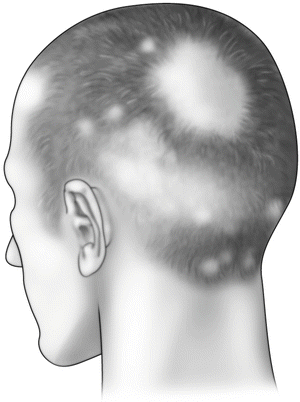, Toral Patel3, 4, Neill T. Peters3, 2 and Sarah Kasprowicz5
(1)
Northwestern University Feinberg School of Medicine, Chicago, IL, USA
(2)
Medical Dermatology Associates of Chicago, Chicago, IL, USA
(3)
Instructor of Clinical Dermatology, Northwestern University Feinberg School of Medicine, Chicago, IL, USA
(4)
D&A Dermatology, Chicago, IL, USA
(5)
NorthShore University HealthSystem, University of Chicago, Pritzker School of Medicine, Chicago, IL, USA
Keywords
Hair lossAndrogenetic alopeciaAlopecia areataRaspberry ketoneProcyanidinsGarlicOnion extractAromatherapyHypnotherapyIntroduction
Hair loss is a commonly encountered complaint in dermatology, and it is a condition that can cause significant psychosocial distress and decreased quality of life in affected patients (Reid et al. 2012). Androgenetic alopecia and alopecia areata, both nonscarring forms of hair loss, are perhaps the most common types of alopecia encountered in practice. While a number of complementary and alternative therapies have been anecdotally reported to be effective in their treatment, there remains a lack of robust evidence supporting any of these modalities to be as effective as standard pharmacologic therapies. Nevertheless, it is beneficial to be aware of the small case reports in the literature, as patients often inquire about “natural” remedies for their hair loss, and many times the results of standard pharmacotherapy are suboptimal. Additionally, as hair loss has few significant medical implications—though clearly has tremendous psychological impact, of course—the risk-benefit calculation may be very different than that of a more threatening condition.
Clinical Considerations
Top Considerations
See Tables 7.1 and 7.2
.
Table 7.1.
Top clinical considerations for androgenic alopecia.
Treatment | How administered | Notes |
|---|---|---|
Raspberry ketone | Topically once daily | May be difficult to find commercial preparation, minimal data |
Procyanidins | Topically once daily | May be difficult to find commercial preparation, minimal data |
Table 7.2.
Top clinical considerations for alopecia areata.
Treatment | How administered | Notes |
|---|---|---|
Garlic | Five percent gel: topically twice daily | May be difficult to find commercial preparation, has potential to be irritating and malodorous |
Onion | Fresh juice: topically twice daily | Has potential to be irritating and malodorous |
Aromatherapy | Mixture of essential oils: topically once daily | Very gentle and fairly easy to obtain and use as an adjunct |
Hypnotherapy | No defined protocol | Can be expensive and requires time commitment; unclear protocol adds variability |
Androgenetic Alopecia
Androgenetic alopecia (AGA) is a hereditary, nonscarring form of hair loss mediated by the effects of dihydrotestosterone (DHT) on the hair follicle. Progressive miniaturization of the hair follicle leads to hair loss in both male and female pattern hair loss. Male pattern AGA classically manifests as thinning over the vertex and fronto-temporal scalp; female pattern AGA can manifest as thinning over the crown with preservation of the frontal hairline, widening of the central part, or thinning with bitemporal recession (Blume-Peytavi et al. 2011).
Raspberry Ketone
Raspberry ketone (RK) is an aromatic compound found in red raspberries; it is similar in structure to capsaicin. The mechanism of action for raspberry ketone in promoting hair growth is thought to be due the increase of dermal insulin-like growth factor-1 via the stimulation of sensory neurons (Ulbricht et al. 2013). Applied topically, it may have some effect on both AGA and alopecia areata (AA), perhaps via induction of insulin-like growth factor-1.
Evidence for Raspberry Ketone
1.
Effect of topical application of raspberry ketone on dermal production of insulin-like growth factor-1 in mice and on hair growth and skin elasticity in humans. Harada N, Okalima K, Narimatsu N, Kurihara H, Nakagata N. Growth Horm IGF Res. 2008 Aug;18(4):335–44.
In this small study, a topical formulation containing 0.01 % RK was applied once daily to the scalp of ten human volunteers for 5 months: 6 with androgenetic alopecia, 4 with alopecia areata. The authors state that hair growth was seen in five of the ten volunteers after 5 months of use. Remarkably, they do not offer further breakdown of the data, but the figure does show both AGA and AA apparently improving with the topical RK application.
Procyanidins
Procyanidins are a class of flavonoids found in red wine, chocolate, barley, grape seed and apples, among other sources. They are increasingly being studied for their health benefits due to their potent antioxidative properties (Hammerstone et al. 2000; Chun et al. 2007). Procyanidin B-2, found in high concentrations in apples, has been specifically studied as a therapeutic agent for androgenetic alopecia.
Evidence for Procyanidins
Stay updated, free articles. Join our Telegram channel

Full access? Get Clinical Tree









